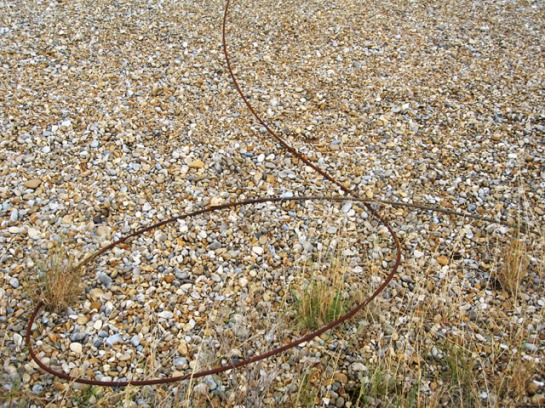beacon: air on a hinge
On the 8th September my field-recording from the door of the Black Beacon on Orford Ness will be played at the New York Public Library as part of Kinokophonography: an evening of audible cinema curated by Kinokophone.
Formed by the prevailing winds of longshore drift, the shingle spit of Orford Ness is now a National Nature Reserve. Previously the site of an early radar navigation system, during the Second World War the ness was also used as an Atomic Weapons Research Establishment. The ness remains haunted by the abandoned buildings and unexploded ordinance of this military occupation.
Orford ness is a restricted landscape; visitors are warned to keep to the ‘route’ and large areas are off limits. The geometry of blast walls, laboratories and observation stations interrupts the terrain. The architecture of these derelict sentinels quietly observes the horizon, amplifying a sense of vacant stillness. Through the concrete stare of windows, the buildings keep watch on this vacancy, the isolation and secrecy of their accommodation, strangely reminiscent of bird hides. On the roof of bomb ballistics building, binoculars place the ness under the surveillance of a military lens, a series of lines measure and map the landscape viewed. Whilst a breeze ascending the metal staircase, surrounds the building in a harmonic mist, an almost inaudible howl, which hangs in the air like tinnitus.
In accordance with the source of its formation, the soundscape of Orford ness is dominated by the aerial and intermittent: the rumble of wind against the ear, the pits of silence that appear when the breeze drops or is physically obscured. Inside the buildings and behind the blast doors, the occasional draft and clatter of metal interrupts an empty quiet. Outside, animated by the wind, the rope of a flagless pole taps out a signal of distress: a telegraph of unknown content delivered to an anonymous recipient.
air on a hinge: composition for three doors
A monochrome tower in a flat and pallid landscape, inclined to the ocular, the Black Beacon seems appropriately conspicuous. The word ‘beacon’ has its etymological roots in light, fire and desired visibility. However, in counterpoint to this emphasis on the visible the conspicuity of the Black Beacon also results from an allusion to the unseen, invisible and auditory. Built in 1929 as part of the Orfordness Rotating Wireless Beacon Radar System the Black Beacon was once part of an audible map of the terrain. (Ra)dio (d)etecting (a)nd (r)anging the unseen, the beacon provided a navigational fix for those otherwise lost at sea.
As I climbed the stairs of the beacon my ear was caught by a slight and plaintive whine. This transmission was occasional and intermittent, suspended moans followed by sharp high frequency yelps. I used the rotation of my ear and the volume of the sound to detect the site of its origin. Through this physical radar, my ear (and eye) fixed on the rusted hinge of a door, which, when caught by the draft of a sea breeze, transmitted a sonorous aerial code. As part of its station sequence the Black Beacon had once broadcast in Morse the letters “V” and “B”, now the hinged air pronounced its own alphabet, an ethereal dot and dash, a persistent unanswered signal enunciating loss.







